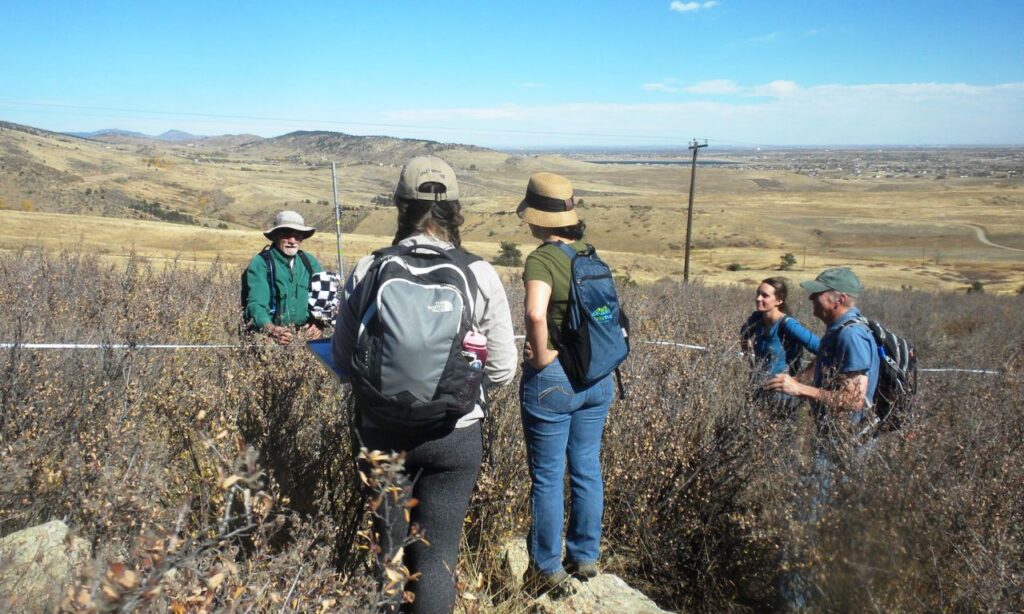Sometimes scientists wear Carhartt’s and a winter coat. At least that is true for our wildlife biologists and volunteers who measure the impact of elk on shrubs at the Ron Stewart Preserve at Rabbit Mountain Open Space (RSP@RM).
The team specifically measures mountain mahogany plants. This native shrub is an important food for elk when grass is under snow. Vegetation monitoring showed significant impact when the elk herd reached its peak of 360 elk in 2016. Shrubs that have been chewed by elk exhibit a “clubby” growth pattern and will show very little new growth. That is why the department uses them as an indicator of how much impact elk have on their environment. We are tracking the impact over time as the elk management plan on the property takes effect.
In late fall and throughout winter, teams of volunteer citizen scientists and our biologists trek out 11 transects on the property. We go at this time of year for several reasons — it is a time when we will have less impact on the shrubs since their seasonal growth is complete and it is also when we are least likely to encounter an abundant resident, the prairie rattlesnake. Six of our transects are in an area identified as a high-use area for elk, while the other five are located where elk are not typically found.
Once the start of a transect is located, one researcher will walk 75 meters along a tape while the rest of the cohort gives direction to keep that person on bearing. In some of our control transects, the tape walker is pushing through shrubs over six feet tall. It’s easy to get a little off track when you can’t see out! Last year I joined in the fun and discovered what a challenge it can be to stay on course when navigating through shrubs that were taller than I am. Mountain mahogany is quite resistant to humans trying to walk in a straight line. Perhaps that is why we found so many bobcat tracks among these dense stands. The shrubs provide excellent habitat for the bobcat as well as the rabbits they hunt.
Let’s Review the Data
We measured individual shrubs every five meters on each side of the tape until a total of 50 individual plants were examined. Each shrub has an approximate age, height, and clubbiness quotient recorded. Then we used a cover blanket to measure how much area is covered by mountain mahogany. We placed the blanket at 15-meter intervals so that a photo can reveal percent of coverage by the shrubs. The cover blanket shows how full and healthy plants may be against a measurable backdrop: lush and tall in the control area; short and clubby in the treatment area. Measurements over time will show how the shrubs in the treatment area recover. Of course, all of this is made nearly impossible if the wind doesn’t cooperate. Our cover blanket becomes a sail in the wrong conditions. The data is compiled by wildlife biologists to determine what impact the elk have in areas where elk are known to feed versus the areas where the elk are absent.
Trends in data over the years are promising. According to wildlife biologist Dave Hoerath, “The subunit harvest is working. Population numbers are down, occupancy in the elk core use area at RSP@RM is much reduced, and there are some indications of healing in trail corridors, bedding areas, and heavily browsed shrub stands.”
If you are interested in becoming a volunteer shrub monitor this year, apply by Sept. 30, at boco.org/bcposvolunteer.
A Brief History of Elk at Ron Stewart Preserve at Rabbit Mountain
You may be thinking to yourself, “Wait, I’ve been to Rabbit Mountain loads of times and I’ve never seen an elk. How can we possibly need to manage the elk population there?”
It’s true, that the elk herd is often difficult, if not impossible, for the casual visitor to see, especially without binoculars. However, the animals are there. Historically, and until about 2010, this open space hosted a herd of about 25 to 75 elk. In the summers the herd sized diminished down to about 30, and elk migrating down from the mountains would swell the herd up toward about 75 in the winter season.
Around 2010, the herd started a dramatic increase, reaching a peak of more than 350 elk in 2016. The animals were causing significant impacts to vegetation, both on the preserve as well as in neighboring farm fields. There was also damage to infrastructure and an increase in collisions with vehicles.
All these factors led to the necessity of a management plan for this herd. Boulder County Parks & Open Space partnered with Colorado Parks and Wildlife to create a hunting subunit that included RSP@RM along with mostly privately held lands. The goal was to bring herd size back down to the 30 to 75 elk so that vegetation and habitat could recover to sustainable levels. Not only would hunting bring numbers down, but it would also influence the behavior of the herd so that not as many elk would stay on property year-round.
And it’s working! Our native plants are starting to bounce back. We are close to the target number. This year, there will be only two hunters on property per week (in years past there were three). In addition, hunting will start later in the year and be allowed only on Mondays and Tuesdays rather than three days a week. The department will continue to partner with Colorado Parks and Wildlife to conduct annual counts, and our shrub monitors will keep checking to observe the impacts of elk on our native plants.

